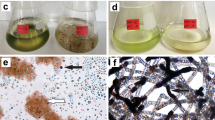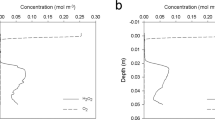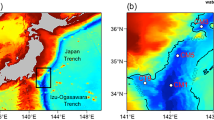Abstract
Humic substances form through the degradation of microbial and plant precursors, and make up a significant fraction of natural organic matter in terrestrial and aquatic environments1. Humic substances are redox-active2,3,4 and can act as terminal electron acceptors in anaerobic microbial respiration4. Reduced humic substances may become re-oxidized during aeration of temporarily anoxic systems, such as wetlands, sediments and many soils. If the transfer of electrons from anaerobic respiration through humic substances to oxygen is sustained over many redox cycles, it may competitively suppress electron transfer to carbon dioxide, and thereby lower the formation of methane in temporarily anoxic systems5,6,7,8. Here, we monitor changes in the redox states of four chemically distinct dissolved humic substances over successive cycles of reduction by the bacterium Shewanella oneidensis MR-1 and oxidation by oxygen, in a series of laboratory experiments. We show that electron transfer to and from these substances is fully reversible and sustainable over successive redox cycles. We suggest that redox cycling of humic substances may largely suppress methane production in temporarily anoxic systems.
This is a preview of subscription content, access via your institution
Access options
Subscribe to this journal
Receive 12 print issues and online access
$259.00 per year
only $21.58 per issue
Buy this article
- Purchase on Springer Link
- Instant access to full article PDF
Prices may be subject to local taxes which are calculated during checkout




Similar content being viewed by others
References
Stevenson, F. J. Humus Chemistry: Genesis, Composition, Reactions (John Wiley, (1994).
Scott, D. T., McKnight, D. M., Blunt-Harris, E. L., Kolesar, S. E. & Lovley, D. R. Quinone moieties act as electron acceptors in the reduction of humic substances by humics-reducing microorganisms. Environ. Sci. Tech. 32, 2984–2989 (1998).
Aeschbacher, M., Sander, M. & Schwarzenbach, R. P. Novel electrochemical approach to assess the redox properties of humic substances. Environ. Sci. Tech. 44, 87–93 (2010).
Lovley, D. R., Coates, J. D., BluntHarris, E. L., Phillips, E. J. P. & Woodward, J. C. Humic substances as electron acceptors for microbial respiration. Nature 382, 445–448 (1996).
Keller, J. K., Weisenhorn, P. B. & Megonigal, J. P. Humic acids as electron acceptors in wetland decomposition. Soil Biol. Biochem. 41, 1518–1522 (2009).
Blodau, C. & Deppe, M. Humic acid addition lowers methane release in peats of the Mer Bleue bog, Canada. Soil Biol. Biochem. 52, 96–98 (2012).
Keller, J. K. & Takagi, K. K. Solid-phase organic matter reduction regulates anaerobic decomposition in bog soil. Ecosphere 4, 1–10 (2013).
Bridgham, S. D., Cadillo-Quiroz, H., Keller, J. K. & Zhuang, Q. L. Methane emissions from wetlands: biogeochemical, microbial, and modeling perspectives from local to global scales. Glob. Change Biol. 19, 1325–1346 (2013).
Roden, E. E. et al. Extracellular electron transfer through microbial reduction of solid-phase humic substances. Nature Geosci. 3, 417–421 (2010).
Aeschbacher, M., Vergari, D., Schwarzenbach, R. P. & Sander, M. Electrochemical analysis of proton and electron transfer equilibria of the reducible moieties in humic acids. Environ. Sci. Tech. 45, 8385–8394 (2011).
Lovley, D. R., Fraga, J. L., Coates, J. D. & Blunt-Harris, E. L. Humics as an electron donor for anaerobic respiration. Environ. Microbiol. 1, 89–98 (1999).
Kappler, A., Benz, M., Schink, B. & Brune, A. Electron shuttling via humic acids in microbial iron(III) reduction in a freshwater sediment. Fems Microbiol. Ecol. 47, 85–92 (2004).
Wolf, M., Kappler, A., Jiang, J. & Meckenstock, R. U. Effects of humic substances and quinones at low concentrations on ferrihydrite reduction by Geobacter metallireducens. Environ. Sci. Tech. 43, 5679–5685 (2009).
Borch, T. et al. Biogeochemical redox processes and their impact on contaminant dynamics. Environ. Sci. Tech. 44, 15–23 (2010).
Denman, K. L. et al. in Climate Change 2007: The Physical Science Basis (ed Solomon, S.et al.) Couplings between changes in the climate system and biogeochemistry. (Cambridge Univ. Press, 2007).
Ratasuk, N. & Nanny, M. A. Characterization and quantification of reversible redox sites in humic substances. Environ. Sci. Tech. 41, 7844–7850 (2007).
Bauer, I. & Kappler, A. Rates and extent of reduction of Fe(III) compounds and O2 by humic substances. Environ. Sci. Tech. 43, 4902–4908 (2009).
Todorova, S. G. & Costello, A. M. Design of Shewanella-specific 16S rRNA primers and application to analysis of Shewanella in a minerotrophic wetland. Environ. Microbiol. 8, 426–432 (2006).
Ziemke, F., Brettar, I. & Hofle, M. G. Stability and diversity of the genetic structure of a Shewanella putrefaciens population in the water column of the central Baltic. Aquat. Microbial. Ecol. 13, 63–74 (1997).
Dichristina, T. J. & Delong, E. F. Design and application of rRNA-targeted oligonucleotide probes for the dissimilatory iron- and manganese-reducing bacterium Shewanella putrefaciens. Appl. Environ. Microbiol. 59, 4152–4160 (1993).
Lovley, D. R., Phillips, E. J. P. & Lonergan, D. J. Hydrogen and formate oxidation coupled to dissimilatory reduction of iron or manganese by Alteromonas putrefaciens. Appl. Environ. Microbiol. 55, 700–706 (1989).
Jiang, J. & Kappler, A. Kinetics of microbial and chemical reduction of humic substances: Implications for electron shuttling. Environ. Sci. Tech. 42, 3563–3569 (2008).
Watson, V. J. & Logan, B. E. Power production in MFCs inoculated with Shewanella oneidensis MR-1 or mixed cultures. Biotechnol. Bioeng. 105, 489–498 (2010).
Marsili, E. et al. Shewanella secretes flavins that mediate extracellular electron transfer. Proc. Natl Acad. Sci. USA 105, 3968–3973 (2008).
Kotloski, N. J. & Gralnick, J. A. Flavin electron shuttles dominate extracellular electron transfer by Shewanella oneidensis. Mbio 4, 1–4 (2013).
Blodau, C. Carbon cycling in peatlands - A review of processes and controls. Environ. Rev. 10, 111–134 (2002).
Madigan, M. T., Martinko, J. M., Stahl, D. A. & Clark, D. P. Brock Biology of Microorganisms (Pearson Education, (2012).
Straub, K. L., Benz, M. & Schink, B. Iron metabolism in anoxic environments at near neutral pH. Fems Microbiol. Ecol. 34, 181–186 (2001).
Hegler, F., Posth, N. R., Jiang, J. & Kappler, A. Physiology of phototrophic iron(II)-oxidizing bacteria: implications for modern and ancient environments. Fems Microbiol. Ecol. 66, 250–260 (2008).
Myers, C. R. & Myers, J. M. Ferric iron reduction-linked growth yields of Shewanella putrefaciencs MR-1. J. Appl. Bacteriol. 76, 253–258 (1994).
Acknowledgements
This research was financially supported by grants from the Swiss National Science Foundation to M.S. and L.K. (Project 200021–135515) and from the German Research Foundation to A.K. and A.P. (KA 1736/3-2, research group eTrap). We thank M. Aeschbacher, S. E. Page, J. Keller, K-H. Knorr, C. A. Gorski, K. Wammer and K. McNeill for discussions.
Author information
Authors and Affiliations
Contributions
The concept of redox cycling of HAs was developed by A.P., A.K., L.K. and M.S. M.S. and A.K. coordinated the overall project. L.K. and M.S. conducted redox cycling and electrochemical analyses of HA and model compounds, analysed the data, and wrote the paper. A.P. and A.K. prepared the HA and model compound solutions and the S. oneidensis MR-1 inocula, and contributed to writing the paper.
Corresponding authors
Ethics declarations
Competing interests
The authors declare no competing financial interests.
Supplementary information
Supplementary Information
Supplementary Information (PDF 12460 kb)
Rights and permissions
About this article
Cite this article
Klüpfel, L., Piepenbrock, A., Kappler, A. et al. Humic substances as fully regenerable electron acceptors in recurrently anoxic environments. Nature Geosci 7, 195–200 (2014). https://doi.org/10.1038/ngeo2084
Received:
Accepted:
Published:
Issue Date:
DOI: https://doi.org/10.1038/ngeo2084
This article is cited by
-
Humic acid-dependent respiratory growth of Methanosarcina acetivorans involves pyrroloquinoline quinone
The ISME Journal (2023)
-
Coupled iron cycling and organic matter transformation across redox interfaces
Nature Reviews Earth & Environment (2023)
-
Modified Biochar for Arsenic Immobilization in Soil: A Critical Review
Reviews of Environmental Contamination and Toxicology (2023)
-
Redox controls on anaerobic ammonium oxidation coupled to reduction of natural organic matter in paddy ecosystems
Biology and Fertility of Soils (2023)
-
Effects of aquatic dissolved organic matter redox state on adsorption to goethite
Aquatic Sciences (2023)



